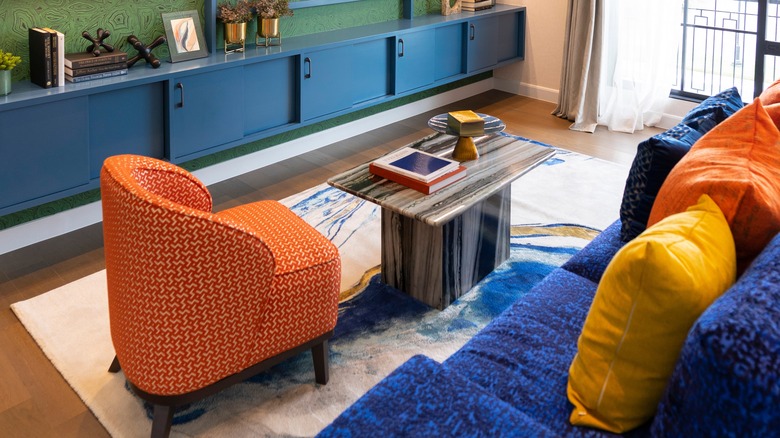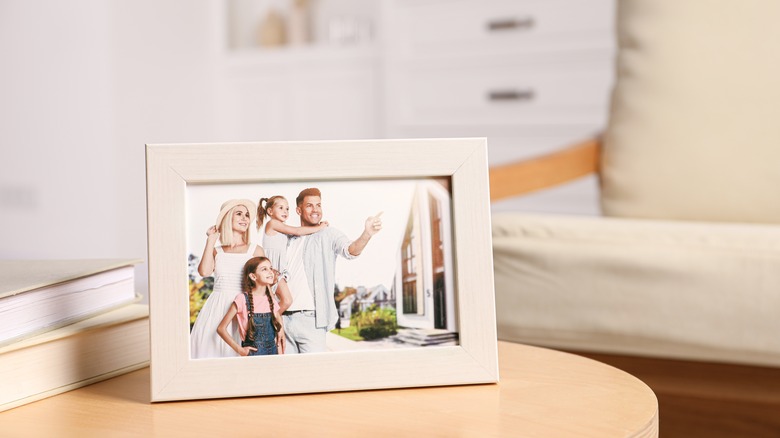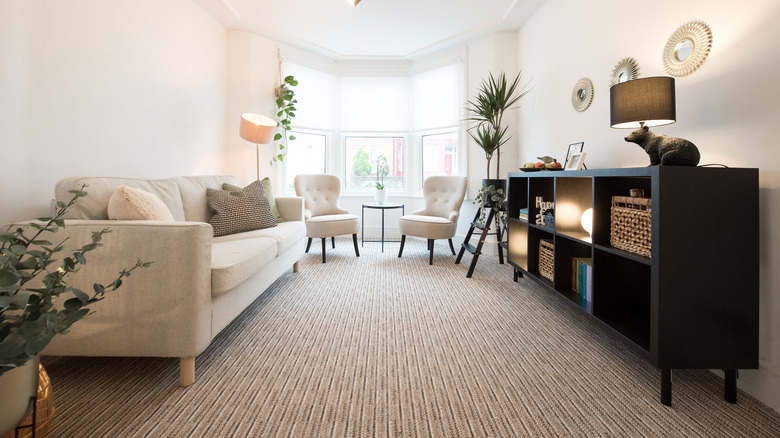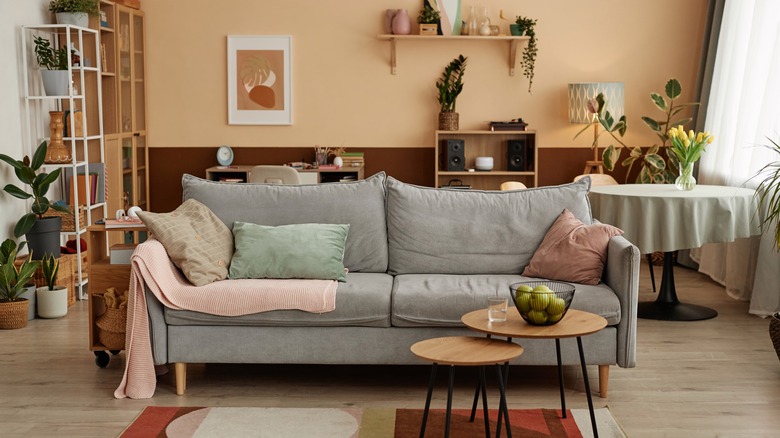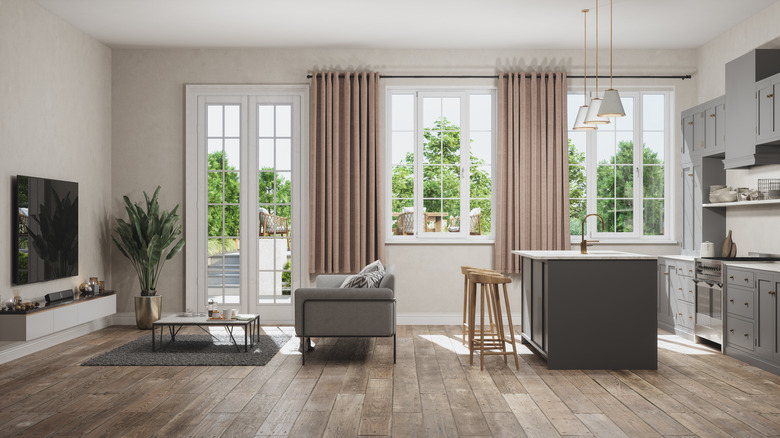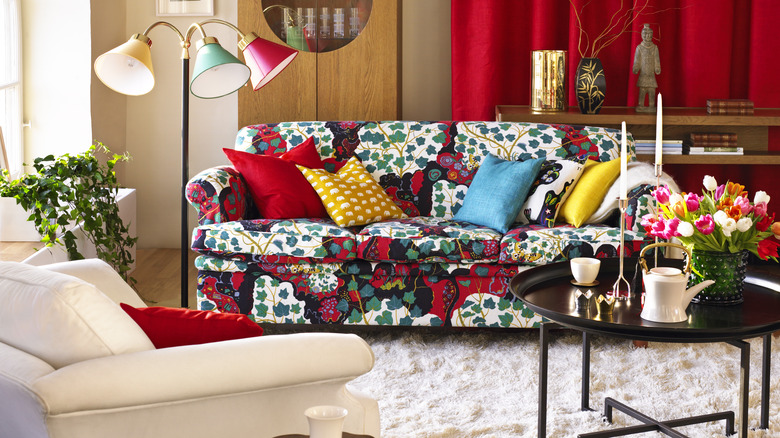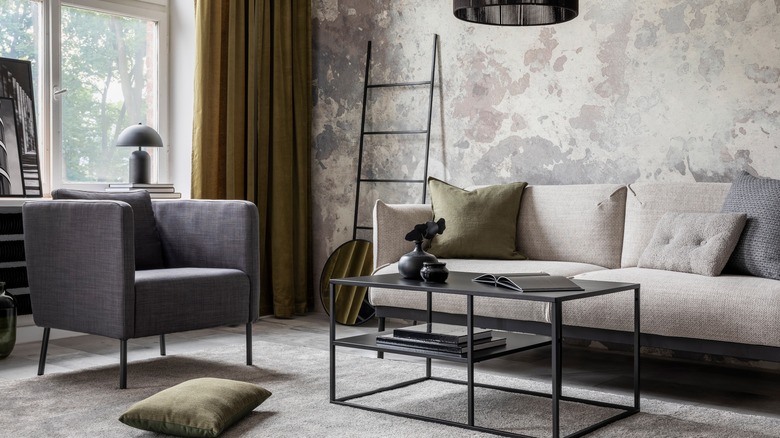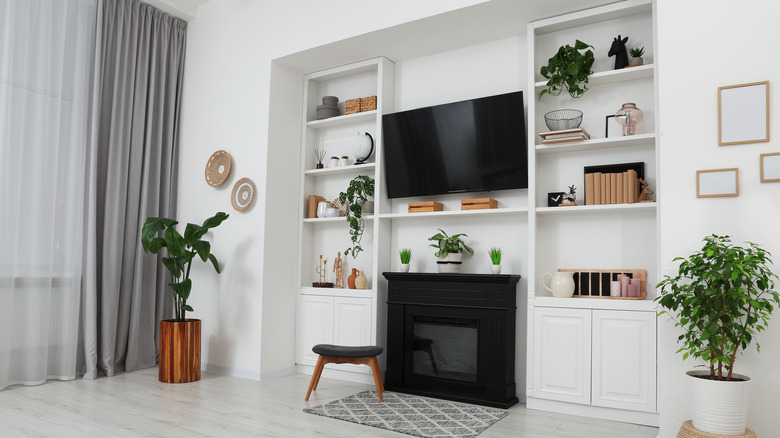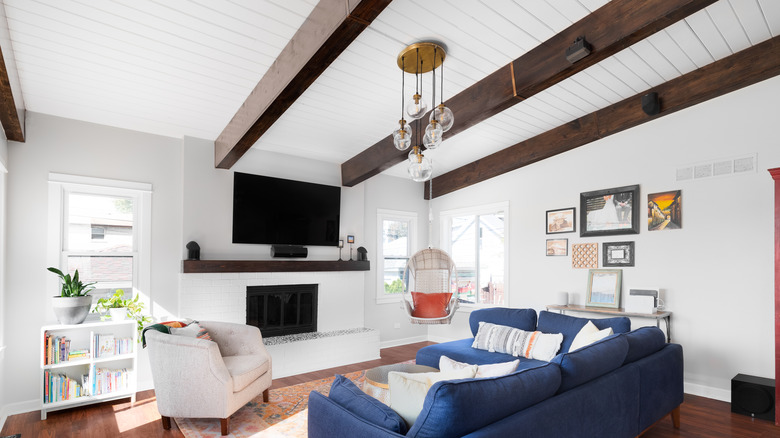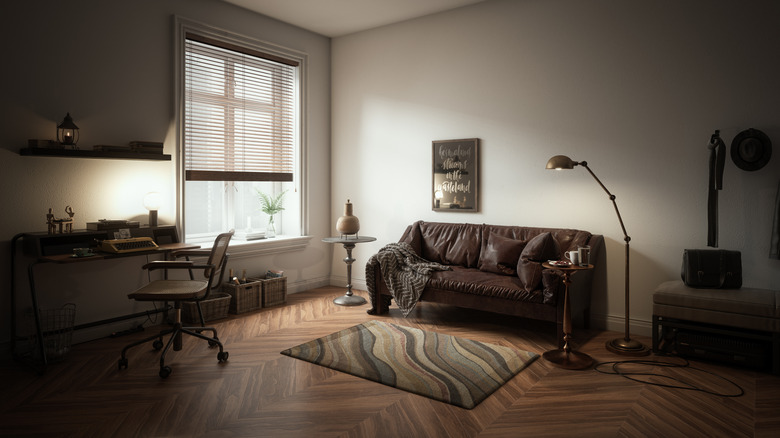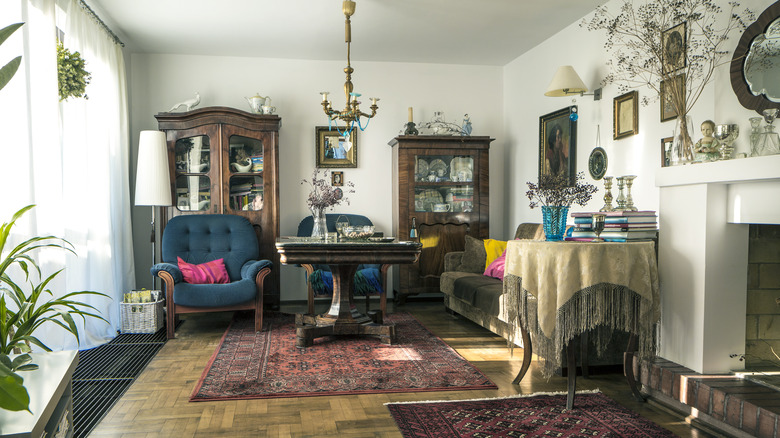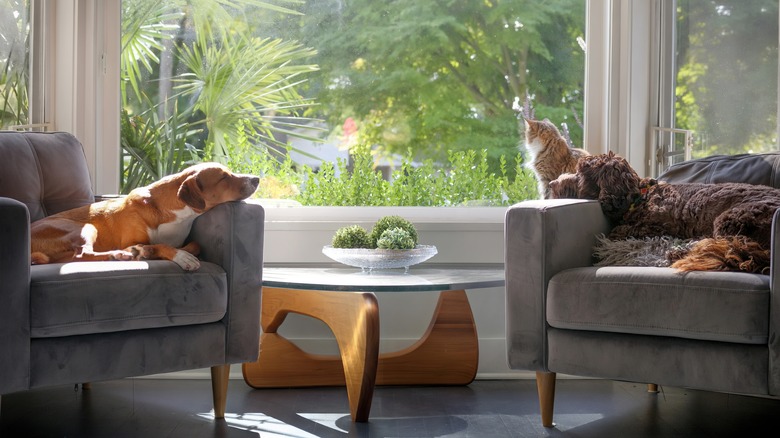Living Room Design Choices That Are Making It Harder To Sell Your Home
Selling your house can often feel like you're taking a shot in the dark. It can be tough to pinpoint what might be discouraging buyers from making an offer. You want to make a quick sale, but if showings are booked and buyers keep walking away, it's time to make some changes. If there is nothing obviously deterring them — like an old roof or visible mold in the bathroom — then it's worth examining the smaller details. A great place to start is the living room.
The living room is where the family relaxes. It's where you unwind after a long day of work, and also the spot you entertain friends and guests. You want it to feel welcoming, up-to-date, and stylish. If it doesn't meet those standards, it could be a big reason why you aren't fielding as many offers as you would like. We often become blind to what could be off-putting in our spaces, so to help, we turned to real estate experts. These professional agents, brokers, investors, and flippers share some of the biggest living room design mistakes that could hinder your home's sale. If you're struggling to move your house off the market, consider addressing some of these issues.
Overly personalized decor can be a deterrent
The house you've lived in for years is full of personal touches, especially in the cozy, gathering space of the living room. Photos adorn the walls, mementos litter the shelves, inherited furniture spice up dull corners, and the list goes on. While that's perfectly fine and normal, if you're trying to sell your home and organizing open houses, it's time to consider packing away some of these personal touches. "Buyers often struggle to visualize themselves in a home filled with personal items," Alexis Orivri, real estate investor and founder of Riv Buys Properties, exclusively tells House Digest. "While personalization is great for living in the house, it can be a deterrent when selling."
If you have showings lined up, consider doing some early packing. This means wrapping up your bobblehead collection in tissue paper and boxing up any potentially polarizing books on your bookshelves. And while a photo frame or two can be left out (after all, you're not sure how long your home will take to sell, and you don't want it to feel too uninviting,) the gallery wall of family photos can come down.
Outdated fixtures or finishes can make the home feel like a project
If you're having a tough time holding buyers' attention, it might be time to take a closer look at the fixtures and finishes in your living room. If they hark back to the '80s or look like they have seen better days, you'll only capture the attention of buyers who either want to roll up their sleeves and DIY some major changes or those who want to haggle with you for a lower price. "A major turn-off for buyers is seeing that they have to do work to make it their own," Michael McGuirk, a licensed real estate agent in New York and Connecticut with Sotheby's International Realty, warns. "In the living room, this could be wall-to-wall carpeting, a popcorn ceiling, or even wallpaper, which not only can look outdated, but does not match their style. Knowing they have to do immediate renovations on a home can easily put the brakes on them putting in an offer."
While it might cost a pretty penny to rip out your carpet — especially if you don't have hardwood underneath — you can instead tackle easier makeovers. For instance, swap out that old-fashioned boob light in the middle of the room for a contemporary chandelier, such as the Marilyn Chandelier from McGee & Co. The same goes for those brassy sconces with a decade's worth of dust accumulated inside. Instead, trade them in for something modern, like the matching Marilyn Sconces. Similarly, if dated wall colors are your problem, it's time to paint over them with something neutral, like greige or a creamy white.
Cluttered and overcrowded rooms can make the house seem nonfunctional
You might love your overabundance of knick-knacks and your carefully curated furniture, but if they're tightly packed into the space, it can be difficult for potential buyers to see what the room looks like. Even worse, they might be making it appear smaller than it actually is. "A common mistake seen in many living room designs is the overcrowding of furniture and items, making the space look cluttered and cramped. This can be a major turn-off for potential buyers as it gives the impression that the room is small and lacks functionality," Robert Fausette, real estate investor and founder of Revival Homebuyer, tells House Digest.
To avoid this issue, declutter your living room before the first showing takes place. "Keep only essential pieces of furniture and decor, and make sure there is enough space for people to move around comfortably," he advises. "This will not only make the room appear more spacious but also allow buyers to visualize their own furniture in the space." When they can picture themselves surrounded by their things in the room, you're one step closer to clinching the sale. While boxing up decor might be easy, stashing furniture is trickier. Consider moving it into the basement if you have one, or rent a budget-friendly storage unit if you need to prune back quite a few pieces.
Open concept overload can make your house seem disjointed
HGTV shows will have you thinking that the majority of buyers want open floor plans. Each episode seems to feature several walls being knocked down to expand the kitchen or increase the flow. However, it turns out the nation is divided. According to a 2023 Rocket Homes survey, 51.2% prefer an open floor plan, whereas 48.8% prefer to have segmented walls. Because of this, most people are moving toward a more hybrid approach, where the space is more open than your typical traditional home, but there are still some walls up to create private nooks. So if your living room has zero walls in it and bleeds into the surrounding living spaces, buyers might be turned off. "While open floor plans are popular, too much openness can be a drawback. Some buyers still prefer defined spaces, and removing too many walls can make the home feel less functional," Orivri warns.
Chances are you won't hire a construction crew to put up more walls just to sell your home. However, there are ways you can stage it to show buyers it can be more segmented than it appears. Use rugs to create different "rooms", which will trick the eye into seeing different zones thanks to the outlines. (In fact, this is one of Emily Henderson's top tips for decorating an open floor plan.) If you don't want to invest in area rugs, you can instead define an open-concept space with paint. You can also create boundaries with furniture. For example, adding a sideboard behind the sofa creates a clear divide between the living room and dining room. It acts as an invisible wall, making the open floor plan feel less, well, open.
Overly bold colors can be a turn off
If you love color, you might have chosen to decorate your living room accordingly. And that's wonderful — maximalists thrive when surrounded by bold hues and playful color palettes. But if you're trying to sell your house, you might want to consider toning it down for the good of your investment. "A frequent error homeowners make in living room design is opting for bold and vibrant colors on walls or furniture. While bright and bold colors can add personality to a space, they can also be overwhelming for potential buyers," Keith Sant, the founder and CEO of Kind House Buyers, exclusively tells House Digest. "These colors may not match the buyer's personal style or may clash with their existing furniture and decor, making it difficult for them to picture themselves living in the space." Additionally, some people really dislike painting, so having to do it right after moving in could be a major turn-off. "The buyer who pays a higher retail price often lacks vision. If they have to jump through hoops in their mind to erase a dominant red room into something different, they usually will pass on making an offer," warns Jeff Lichtenstein, owner and broker of Echo Fine Properties, a luxury residential brokerage.
The good news is that this can be solved with a few gallons of paint and an afternoon. "To avoid turning off potential buyers, opt for neutral tones such as white, beige, or light gray. This creates a blank canvas for buyers to envision their own style in the space," Sant explains. For the most bang for your buck, consider painting your living room in a neutral shade that has been proven to help fetch a higher offer. According to Zillow's 2023 paint color analysis, which is its most recent one, a dark gray living room typically fetches $1,755 more than one painted in other colors, including light ones.
A living room with a strong design trend can be polarizing
We all have our preferred styles, and our living rooms are great places to experiment with them. For some, that means embracing farmhouse aesthetics with shiplap and white-washed accents. For others, it could be an industrial look with open bookcases and black metal furniture. However, if you're trying to sell your home, it might be time to pack away some of those defining accents. "According to Zillow's Consumer Housing Trends Report, homes with overly trendy or highly specific designs can stay on the market for up to 11 days longer than those with more neutral, widely appealing decor," Ryan Zomorodi, real estate investor and co-founder at Real Estate Skills, exclusively tells House Digest. And different aesthetics turn off buyers for different reasons.
For example, a style that is too modern can make the home feel uninviting if you don't personally subscribe to that look. "Design trends like excessive use of industrial or ultra-modern styles can cause homes to stay on the market longer, as these styles can feel cold or unwelcoming to many buyers looking for a cozy and livable space," Zomorodi warns. On the opposite side of the spectrum, an overly cozy style like farmhouse can also alienate potential buyers. "While popular in the past, farmhouse has now become overdone, contributing to extended market times, especially when executed with cheaper imitation materials. In fact, Zillow also found that homes with outdated decor trends, like shiplap or barn doors, can sell for nearly 4% less than homes with more current designs, indicating that buyers are often wary of homes that feel stuck in past design moments." To help move your house off the market, consider packing up some of your more niche decor and furniture pieces.
Too many architectural features can be a pain
While architectural features are usually sought-after when people are searching for their next forever-home, having too many in one room can feel cluttered and indicate future renovations. After all, if it doesn't fit the buyer's style, they're doing the math of how much time, effort, and money it will take to remove them. "Customized built-ins or unique architectural features can be off-putting if they don't fit the average buyer's taste. While the seller may love bold statement walls or intricate shelving, buyers often prefer clean, flexible spaces," Jake McClure, real estate broker and CEO of Burling Square Group, tells House Digest. Even worse, certain features can cost quite a bit to remove. For instance, ripping out a large built-in bookshelf will not only take a lot of demo, but it will also require the buyer to patch the floor where it once stood and re-drywall and paint the wall and ceiling.
Does this mean you should remove all of the architectural features in your room? Not necessarily. But if your house has been stuck on the market for months, it might be time to see if there are any simple updates you can do to move the sale along. For example, if your living room has faux Styrofoam beams, consider removing them and patching the ceiling. If you have a built-in bookcase and wooden wainscoting that dominates the room, consider painting them white to make them feel more modern, less noticeable, and more appealing to a larger buying pool. Or if you have wall-to-wall mirrors, look into how easy it would be to remove them and patch the walls.
Faux finishes can appear tacky to some
Similarly, you might need to rethink the faux finishes you DIYed one inspired Saturday afternoon. "Something else that buyers don't like? Faux finishings," Dan Staupe, remodler and contractor at Compass Exteriors, shares. "You know how Chip and Joanna love shiplap? Say you've got some in your house but it's fake, it's plastic. I see that a lot. Or fake brick to give the space a Brooklyn loft kind of feel. It's never a good imitation, let's be real. So, of course buyers have a negative first impression." You might also want to steer clear of faux paint finishes, which mimic plaster or other textures.
If you used a peel and stick version of such an accent, then it might be beneficial to remove it. For instance, if you installed peel and stick wainscoting or a temporary accent wall, it might be time to take it down. However, tearing down shiplap and adding new drywall might seem like a large investment, in both time and money. While it shouldn't be your first tweak, it might be something to consider if your house has been sitting idle on the market for months. Some fresh drywall might be just what's standing between you and a "sold" sign.
Lack of natural light can make the living room uninviting
We spend a lot of time in our living rooms, so it's important that they feel inviting. While a dark and moody room might be perfect for unwinding in the evening, it can feel depressing during the day. If your space lacks natural light, it can be part of why you're not getting as many bites as you would like. "Natural light can have a significant impact on the overall feel of a living room. A dark and dimly lit room can be off-putting for potential buyers as it may give the impression of a gloomy and unwelcoming space," Fausette shares. Luckily, there are steps you can take to make your living room feel a little brighter.
"To address this issue, make sure to open up curtains or blinds to let in natural light," he advises. You can also take down valances and swap heavy curtains for sheer ones. "If the room doesn't have many windows, consider adding some additional lighting sources such as floor lamps or recessed lighting to brighten up the space." While you can't magically turn a north-facing window into a south-facing one, you can show buyers that there are strategies in place to make it feel less gloomy. That way, they can just implement the same ideas when that living room becomes theirs.
Displaying outdated or rough furniture can leave a bad impression
You might absolutely love the scarred and ringed coffee table you have had since college, or the dinged and scratched waterfall dresser from your grandma, but having too many outdated or worn pieces in your living room can trip alarm bells in buyers' minds. "Old, worn-out furniture and outdated decor can also be a red flag for potential buyers," Sant warns. "It gives the impression that the home hasn't been updated or taken care of properly." After all, if you can't be bothered to update your coffee table, what other things have you failed to improve in the house?
Luckily, there is an easy fix for this. "Consider investing in some new, modern pieces to freshen up the space and make it more appealing to buyers," he suggests. These can either be inexpensive pieces you can then resell on Facebook Marketplace or items you would like to use in your new home once you move. However, if you don't want to make such a hefty investment, there is a workaround. You can simply remove the rougher-looking pieces and update the room with smaller (and more affordable) accents. "You can also add some trendy decor items such as throw pillows, rugs, and artwork to give the room a contemporary feel," he notes.
Furniture that blocks windows ruins the view
Sometimes we want more furniture than a space allows, which is why we crowd the pieces in front of windows. Whether it's tall chairs, a sideboard, or a bookcase, these pieces might look great for our particular design eye, but they can block some of the benefits of your location for buyers. "People buy homes for views, and often times in a living room, the furniture is too high," Lichtenstein notes. "Make sure the height and furniture do not get in the way of seeing the patio, pool, and view. Especially if the living room is the first room you see when the potential buyer opens up the front door. First impressions can be a killer if they can't visualize immediately."
If you have such pieces, simply remove them. Store them somewhere else in the home, whether that's the garage, basement, or perhaps a storage unit if nothing else is available. While it might seem like a hassle moving out furniture before your house has a "sold" sign out front, it will be worth it if you can get to that goal faster.
